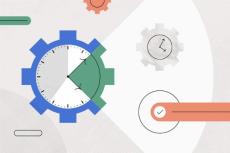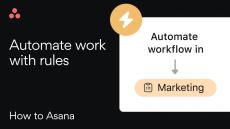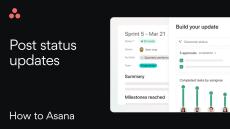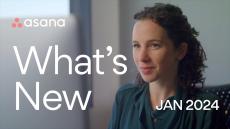|
By Team Asana
AI’s starring role in workplace transformation is now undeniable. CEOs everywhere are asking senior leaders to create strategies for maximum AI impact, while frontline managers and their teams must navigate rolling out this new reality. AI feels like an imperative within all corners of the org chart. Eager to dig deeper, we turned to the latest research from Asana’s Work Innovation Lab, a think tank developing human-centered, cutting-edge research to help businesses evolve.
|
By Caeleigh MacNeil
When brands produce great content, their audience keeps coming back for more. In this article, learn how to create a successful content marketing strategy that keeps your audience engaged. Content marketing isn’t just nice to have—it’s a necessity. Ninety percent of marketers incorporate content into their strategy, and that number is growing. Research projects that the content marketing industry will be worth $600 billion in 2024, a significant uptick from previous years.
|
By Julia Martins
Conducting a feasibility study is an important step in successful project management. By evaluating the viability of a proposed project, a feasibility study helps you identify potential challenges and opportunities, ensuring you make informed decisions. In this guide, we’ll walk you through how to conduct a feasibility study with practical templates and real-world examples, designed for project managers seeking to optimize their project planning process.
|
By Jenny Thai
If your team has ever had trouble getting a project off the ground, or getting a timely status update, or getting work done by deadline, or all of the above, take heart. You’re not alone. Managing projects is hard work. Really hard. But it’s also critical work that can either make or break your team’s ability to hit goals. Enter project management software.
|
By Team Asana
Utilization rate is the measure of available time used for billable work, expressed as a percentage. You can determine utilization rate by dividing a team member’s total number of billed hours by the total hours they have available. In this piece, we’ll explain how to calculate utilization rates and discuss ways to reduce work about work and improve these rates across your team.
|
By Team Asana
Social media audits are an easy way to keep track of your social media accounts. Generally, it’s best to review your accounts quarterly; however, you can choose a frequency that best fits your company’s goals. Below, get the seven key steps to complete a social media audit, plus a free template to keep all of the information in one place. Social media is the place to market your business and reach your customers far and wide.
|
By Caeleigh MacNeil
Long-term goals are objectives you want to achieve months or years down the road. Setting this type of goal gives your work purpose, helps you make better decisions, and offers a hefty dose of daily motivation. In this article, we explain how you can use long-term goals to accomplish big things over time, with examples. When you think of an ideal future for your work, what do you see?
|
By Jenny Thai
Visual project management allows you to see your project tasks and workload displayed in a visual format. When you can see your work, it’s easier to streamline efforts across your team, stay on track, and avoid potential bottlenecks. Often, this is done as a project timeline, calendar, or Kanban board. Learn more about the most common visual project management tools and how to use each (with examples).
|
By Sarah Laoyan
Waterfall project management is a sequential project management methodology that's divided into distinct phases. Each phase begins only after the previous phase is completed. This article explains the stages of the waterfall methodology and how it can help your team achieve their goals. Project managers have many different types of project management methodologies to choose from. There's Agile project management, Kanban project management, Scrum, and many more iterative processes that you can use.
|
By Alicia Raeburn
When launching a new product, organizations are faced with many challenges. For example, issues like fragmented communication, lack of visibility, and unclear goals are common. Learn strategic solutions to streamline processes and enhance team collaboration for successful product launches. On paper, product launches seem deceptively simple—you brainstorm a great product, set a game plan and, with a few adjustments, set a successful launch in motion.
|
By Asana
Welcome to the May edition of What’s new in Asana. First, build rules faster with smart workflows. Next, use the “Viewer” privacy level to give project members view-only access to project information. Finally, filter and sort portfolio items to quickly analyze data and derive insights.
|
By Asana
Bring clarity and visibility to your content marketing team.
|
By Asana
How are executives tackling the challenges of technology-induced friction in the workplace? Our esteemed panelists shared pivotal research from, "The State of Collaboration Technology" and "The State of the IT Leader" reports to discuss actionable strategies for overcoming tech overload. Gain insights that will transform how technology is leveraged within your organization, fostering a more efficient and less stressful work environment.
|
By Asana
Welcome to the April edition of What’s new in Asana. First, create status updates faster with smart status. Asana Intelligence will start a draft status for you, pulling real-time work data in portfolios and goals and highlighting any risks, questions, and roadblocks. Next, save time by quickly duplicating entire sections of tasks within the same project. Finally, use today’s date in a custom field formula calculation to track the duration of progress or time spent on a task.
|
By Asana
Work often includes necessary but repetitive steps. Handoffs to co-workers, approval processes, and triaging requests are all examples of essential, repetitive, and time-consuming work. In this video, learn how to use rules in Asana to automate common steps in your workflows.
|
By Asana
Welcome to the March edition of What’s New in Asana. First, easily share projects with the right groups with the addition of the “share with organization” privacy setting. Next, sort portfolios by connected goals to highlight work related to those goals. Finally, add actual time as an effort field in Workload. You can also compare it to the estimated time.
|
By Asana
Welcome to the February edition of What’s new in Asana.
|
By Asana
Have you been pinged for a status update? Before you fire up the spreadsheets and docs, here's how to do it in Asana. Keep your team in the loop with status updates on projects, portfolios, and goals in Asana. Check out this video to learn how to share status updates using real-time data, the latest highlights, and Asana Intelligence. Then see how your meetings can focus on actionable insights instead of long status readouts.
|
By Asana
What will be the most influential change in how organizations work smarter in 2024? Four future of work experts - Greg Wells, Ph.D., Kelly Monahan, Ph.D., Daan van Rossum, and Rebecca Hinds, Ph.D. - discuss and debate their top predictions. Find out which prediction will rule them all!
|
By Asana
Welcome to the January edition of What’s New in Asana. First, increase the visibility between work and the goals they support with connected goals in the Portfolio view. Next, gain additional control over your projects by adding or clearing a date custom field in rules. Finally, group tasks differently across List and Board views in projects and My Tasks.
- May 2024 (7)
- April 2024 (20)
- March 2024 (19)
- February 2024 (20)
- January 2024 (35)
- December 2023 (12)
- November 2023 (12)
- October 2023 (11)
- September 2023 (2)
- August 2023 (5)
- July 2023 (7)
- June 2023 (7)
- May 2023 (4)
- April 2023 (13)
- March 2023 (4)
- February 2023 (15)
- January 2023 (2)
- December 2022 (1)
- November 2022 (2)
- October 2022 (3)
- September 2022 (1)
- August 2022 (6)
- July 2022 (5)
- June 2022 (7)
- May 2022 (3)
- April 2022 (4)
- March 2022 (3)
- February 2022 (7)
- January 2022 (6)
- December 2021 (3)
- November 2021 (4)
- October 2021 (5)
- September 2021 (11)
- August 2021 (5)
- July 2021 (10)
- June 2021 (13)
- May 2021 (7)
- April 2021 (13)
- March 2021 (5)
- February 2021 (2)
- January 2021 (8)
- December 2020 (6)
- November 2020 (5)
- October 2020 (8)
- September 2020 (12)
- August 2020 (9)
- July 2020 (11)
- June 2020 (14)
- May 2020 (12)
- April 2020 (12)
- March 2020 (7)
- February 2020 (3)
- January 2020 (2)
Asana is a leading work management platform used by teams to stay focused on the goals, projects, and daily tasks that grow your business.
Asana helps you coordinate all the work your team does together. So everyone knows what needs to get done, who’s responsible for doing it, and when it’s due:
- Get organized: Plan and structure work in a way that’s best for you. Set priorities and deadlines. Share details and assign tasks. All in one place.
- Stay on track: Follow projects and tasks through every stage. You know where work stands and can keep everyone aligned on goals.
- Hit deadlines: Create visual project plans to see how every step maps out over time. Pinpoint risks. Eliminate roadblocks. Even when plans change.
Asana is free for teams up to 15 members with unlimited projects and tasks. Web and mobile apps are available at asana.com, iTunes, and Google Play.





















